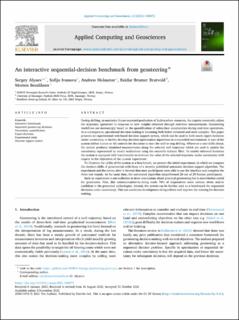| dc.contributor.author | Alyaev, Sergey | |
| dc.contributor.author | Ivanova, Sofija | |
| dc.contributor.author | Holsaeter, Andrew Martin | |
| dc.contributor.author | Bratvold, Reidar Brumer | |
| dc.contributor.author | Bendiksen, Morten | |
| dc.date.accessioned | 2021-11-12T15:04:43Z | |
| dc.date.available | 2021-11-12T15:04:43Z | |
| dc.date.created | 2021-11-10T09:23:56Z | |
| dc.date.issued | 2021 | |
| dc.identifier.issn | 2590-1974 | |
| dc.identifier.uri | https://hdl.handle.net/11250/2829416 | |
| dc.description.abstract | During drilling, to maximize future expected production of hydrocarbon resources, the experts commonly adjust the trajectory (geosteer) in response to new insights obtained through real-time measurements. Geosteering workflows are increasingly based on the quantification of subsurface uncertainties during real-time operations. As a consequence, operational decision-making is becoming both better informed and more complex. This paper presents an experimental web-based decision support system, which can be used to both teach expert decisions under uncertainty or further develop decision optimization algorithms in a controlled environment. A user of the system (either human or AI) controls the decisions to steer the well or stop drilling. Whenever a user drills ahead, the system produces simulated measurements along the selected well trajectory which are used to update the uncertainty represented by model realizations using the ensemble Kalman filter. To enable informed decisions the system is equipped with functionality to evaluate the value of the selected trajectory under uncertainty with respect to the objectives of the current experiment.
To illustrate the utility of the system as a benchmark, we present the initial experiment, in which we compare the decision skills of geoscientists with those of a recently published automatic decision support algorithm. The experiment and the survey after it showed that most participants were able to use the interface and complete the three test rounds. At the same time, the automated algorithm outperformed 28 out of 29 human participants.
Such an experiment is not sufficient to draw conclusions about practical geosteering but is nevertheless useful for geoscience. First, this communication-by-doing made 76% of respondents more curious about and/or confident in the presented technologies. Second, the system can be further used as a benchmark for sequential decisions under uncertainty. This can accelerate development of algorithms and improve the training for decision making. | en_US |
| dc.language.iso | eng | en_US |
| dc.rights | Navngivelse 4.0 Internasjonal | * |
| dc.rights.uri | http://creativecommons.org/licenses/by/4.0/deed.no | * |
| dc.title | An interactive sequential-decision benchmark from geosteering | en_US |
| dc.type | Peer reviewed | en_US |
| dc.type | Journal article | en_US |
| dc.rights.holder | © The Authors, 2021 | |
| dc.description.version | publishedVersion | en_US |
| cristin.ispublished | true | |
| cristin.fulltext | original | |
| cristin.qualitycode | 1 | |
| dc.identifier.doi | 10.1016/j.acags.2021.100072 | |
| dc.identifier.cristin | 1953026 | |
| dc.source.journal | Applied Computing and Geosciences | en_US |
| dc.source.volume | 12 | en_US |
| dc.relation.project | Norges forskningsråd: 268122 | en_US |

